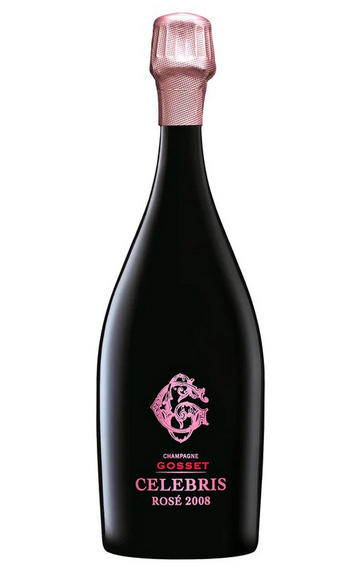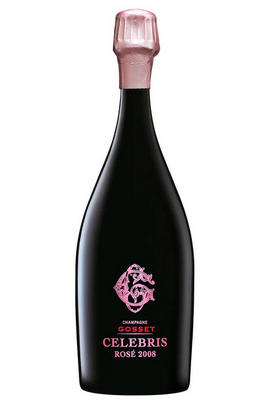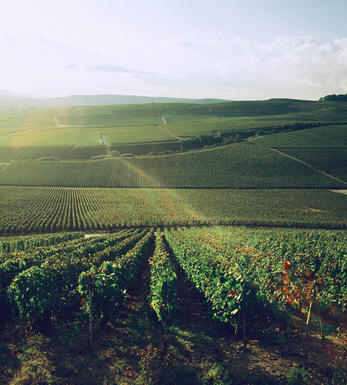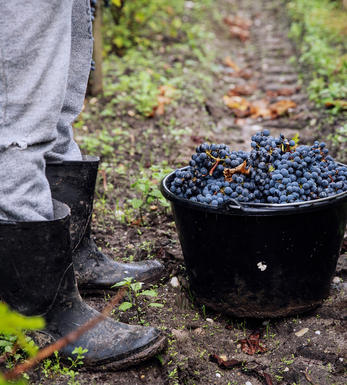
2008 Champagne Gosset, Célébris, Rosé, Extra Brut

Critics reviews
The 2008 Brut Rosé Celebris is an absolutely gorgeous Champagne that captures the essence of the Gosset house style. Bright and ethereal in feel, the 2008 is deceptive in its first impression, but it has plenty of depth to match its decidedly regal, understated personality. The 6.5-gram dosage feels perfectly judged, just enough to fill out the layers and avoid some of the starkness these wines can show, but not so much as to be overpowering. Crushed red berry fruit, chalk, mint and white pepper build as this finely-sculpted Rosé shows off its charms. This is beautifully done. The dosage is 6.5 grams per litre.
Disgorged: April, 2021
Drink 2021 - 2031
Antonio Galloni, Vinous.com (November 2021)
Offering up aromas of honeycomb, warm biscuits, red berries and spices, the just-released 2008 Extra Brut Celebris Rosé is full-bodied, ample and layered, with a concentrated, even expansive mid-palate; but if this Celebris Rosé leads with its voluminous core of fruit, it's its tangy spine of acidity and taut structure that dominates the bone-dry finish. That structure will demand some patience, but this is an impressive effort from Gosset.
Drink 2023 - 2040
William Kelley, Wine Advocate (October 2021)
The skillfully crafted Gosset Champagnes remain in good hands with the current cellar master Odilon de Varine, as evidenced by this fascinating rosé Champagne. Over the past 25 years, the vintage rosé version of this Celebris cuvée has been released only for the 1998, 2003, 2007 and 2008 vintages.
Produced from a blend of grand cru Chardonnay and Pinot Noir with a dosage of 5g/L. The complex bouquet is redolent with delicious pastry notes of the famous pink biscuit of Reims and ripe blackberries. On the palate, this is a powerful, densely textured but beautifully balanced Champagne that merits cellaring for several years for it to come completely into focus.
Drink 2021 - 2030
Yohan Castaing, Decanter.com (December 2021)
Only the fourth-ever release of this cuvée, the 2008 Champagne Celebris Rosé pours an orange/salmon colour and is outstanding on opening, with a perfume of fresh rose petals, honeycomb, and cherry blossoms. Long on the palate, it’s persistent with fresh acidity and feels like it will last for ages. It’s exquisitely detailed, medium to full-bodied, with a soft mineral texture and a refined mousse. Though it is drinking beautifully already, this outstanding wine will improve if cellared in good condition. Drink it over the coming decades.
The oldest wine house in Champagne, established by Pierre Gosset in 1584 in Ay, Gosset, was purchased by Reynaud-Cointreau in 1993. Today, the chef de cave is Odilon de Varine, formerly of Deutz and Henriot, and the philosophy is to adapt to each year and avoid getting stuck in the past. Each of the growers’ plots is fermented separately, and malolactic fermentation is entirely blocked, working with the lees to create roundness in the wines instead.
The house has gradually shifted from being predominantly a Pinot Noir house to that of Chardonnay. Total annual production is approximately 1 million bottles, although they can produce 1.5 million. They hold a considerable stock of reserve wine for 60 years, alleviating the pressures to put out more quantity. This year marks the first release ever for the Celebris Blanc de Blancs.
Drink 2023 - 2043
Audrey Frick, JebDunnuck.com (November 2023)
About this WINE

Gosset
Gosset is the oldest wine-producer in Champagne, with a history stretching back to 1584 – when red, rather than sparkling wines were the region’s calling card.
Situated in the tiny Grand Cru village of Aÿ, five kilometres from Epernay, quality-focused Gosset has some rather famous neighbours, including Bollinger; its production, however, is much below that of the larger Houses, at around 1.3 million bottles (Moët & Chandon, for comparison, makes close to 30 million).
Gosset crafts truly artisan and gastronomic Champagnes, wines which are often seen in Michelin-star restaurants across the world. Newly appointed Chef de Caves Odilon de Varine (who took over in 2016) carries on the hallmark style of the House: extended aging “sur lees” in the cellars gives the wines extra richness and complexity in the finished glass, while the wines often don’tt undergo malolactic fermentation, to preserve the wines’ acidity and freshness. The results tend to be very creamy, dry and full, with rich, biscuit notes, framed by a trademark mineral freshness.
The House produces a range of different wines, including a range of non-vintage bottlings: the House’s flagship multi-vintage blend Grande Réserve, its Blanc de Blancs and Rosé. As for vintage wines, its Grand Millésime is joined by the “prestige” Celebris cuvées, which are only produced in the very best years.
Today the House is owned by the Renaud-Cointreau group, a family firm that also owns Cognac Frapin.

Rosé Champagne
Rosé wines are produced by leaving the juice of red grapes to macerate on their skins for a brief time to extract pigments (natural colourings). However, Rosé Champagne is notable in that it is produced by the addition of a small percentage of red wine – usually Pinot Noir from the village of Bouzy – during blending.
Recommended Producers : Billecart Salmon (Elizabeth Salmon Rose), Ruinart

Champagne blend
Which grapes are included in the blend, and their proportion, is one of the key factors determining the style of most Champagnes. Three grapes are used - Pinot Noir, Chardonnay and Pinot Meunier.
26% of vineyards in Champagne are planted with Chardonnay and it performs best on the Côtes des Blancs and on the chalk slopes south of Epernay. It is relatively simple to grow, although it buds early and thus is susceptible to spring frosts. It produces lighter, fresher wines than those from Burgundy and gives finesse, fruit and elegance to the final blend. It is the sole grape in Blancs de Blancs, which are some of the richest long-lived Champagnes produced.
Pinot Noir accounts for nearly 40% of the plantings in Champagne and lies at the heart of most blends - it gives Champagne its body, structure, strength and grip. It is planted across Champagne and particularly so in the southern Aube district.
The final component is Pinot Meunier and this constitutes nearly 35% of the plantings. Its durability and resistance to spring frosts make the Marne Valley, a notorious frost pocket, its natural home. It ripens well in poor years and produces a soft, fruity style of wine that is ideal for blending with the more assertive flavours of Pinot Noir. Producers allege that Pinot Meunier lacks ageing potential, but this does not deter Krug from including around 15% of it in their final blends.


Buying options
Add to wishlist
Description
The 2008 Brut Rosé Celebris is an absolutely gorgeous Champagne that captures the essence of the Gosset house style. Bright and ethereal in feel, the 2008 is deceptive in its first impression, but it has plenty of depth to match its decidedly regal, understated personality. The 6.5-gram dosage feels perfectly judged, just enough to fill out the layers and avoid some of the starkness these wines can show, but not so much as to be overpowering. Crushed red berry fruit, chalk, mint and white pepper build as this finely-sculpted Rosé shows off its charms. This is beautifully done. The dosage is 6.5 grams per litre.
Disgorged: April, 2021
Drink 2021 - 2031
Antonio Galloni, Vinous.com (November 2021)
wine at a glance
Delivery and quality guarantee